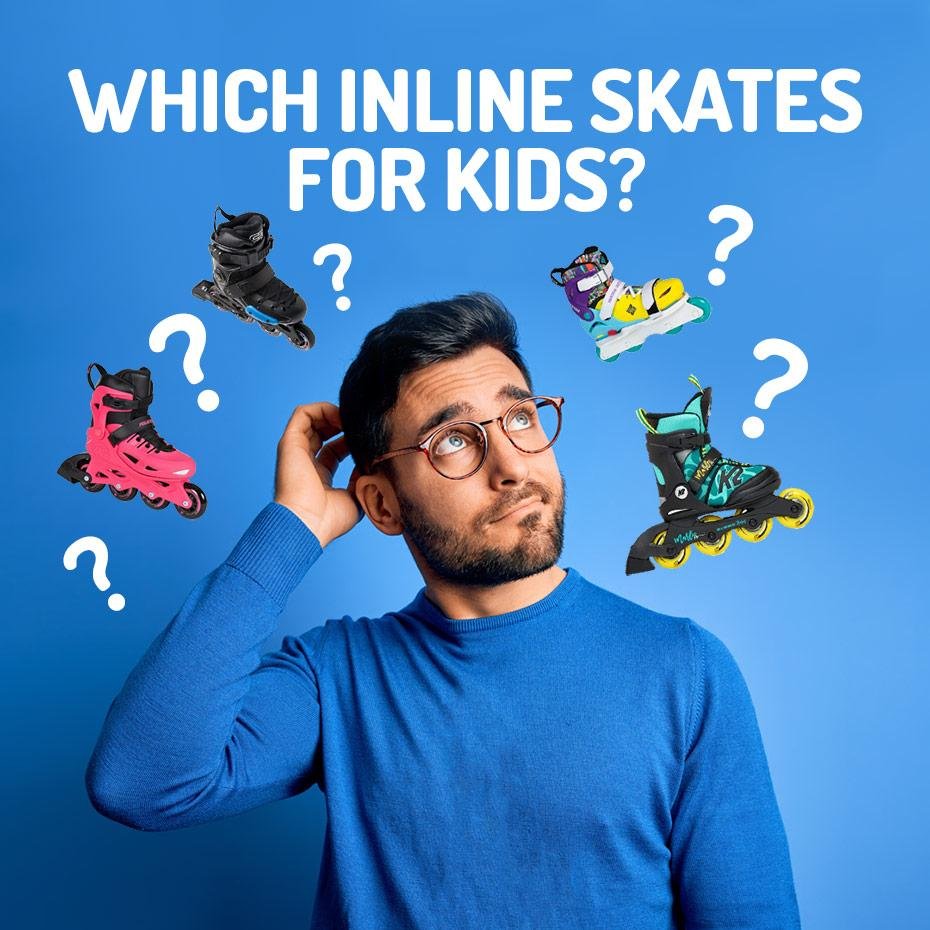How to Choose the Best Inline Skates for Kids – A Guide and Recommended Models
The process of selecting your child's first set of inline skates is exciting yet can feel overwhelming due to the sheer variety of available models, brands, and prices. Known widely as rollerblading, thanks to the widespread popularity of the Rollerblade brand, this activity is a fantastic way for children to spend time actively, boosting their coordination and balance in the process. Choosing the right inline skates will ensure your child experiences plenty of joy and fun. However, opting for low-quality skates could lead to a quick loss of interest in skating. As you read through this article, it's clear you're a dedicated parent concerned with your child's well-being and joy. We're here to guide you through selecting the ideal inline skates for your child.
Features of Good Inline Skates for Kids
Making the right decision and choosing the ideal inline skates for your child involves knowing what to look for in children’s inline skates to ensure a great skating experience. Consider these important elements before your purchase:
- Size Adjustment – Quickly growing feet of children mean that their inline skates need to be adjustable so that they can "grow" along with the child. This allows one pair of skates to be used for miltiple seasons. Some models, including K2, are adjustable over a range of up to 5 sizes. Lack of adjustment is only found in specialized disciplines such as speed skating or advanced freestyle slalom.
- Good Stiffness – Every pair of children's inline skates must adequately support the child's ankle joint. This is crucial for enabling skating with correct technique, offering better control, and thus, facilitating the quicker learning of new skills, enhancing safety, and promoting health while skating. This factor is particularly important because children's muscles are still developing; therefore, the skates should assist in maintaining the correct posture rather than impeding it.
- Buckles and Straps – Inline skates featuring upper buckles enhance the stabilization of the ankle joint and ensure the foot is correctly positioned within the skate. The addition of a lower buckle or strap secures the heel, preventing it from lifting and minimizing unwanted foot movements inside the skate, which in turn decreases the likelihood of blisters and abrasions.
- Comfortable Inner Boot – Known as the "Liner," the inner boot should conform to the shape of the child’s foot, secure proper heel alignment, and most importantly, ensure skating comfort. Top inline skate brands achieve this with the use of high-density foams and neoprene finishes. Adjustable inline skates for kids offer three varieties of inner boots: Stretchable – utilizes stretchy neoprene to adapt to growing feet; Adjustable with an insole – comes with a removable insole to adjust the skate size; and Integrated – features padding that is integrated with the boot’s upper part and can be expanded into two sections
- Frame – The skate frames, crafted from either aluminum or composite materials, are designed to be either mounted to the boot or integrated within the skate's shell(unibody). The lighter composite frames are a hit among young, recreational skaters just beginning their inline skating adventure, thanks to their ease of use. Conversely, the sturdier aluminum frames enhance precision in skating maneuvers and improve the transfer of energy, making them ideal for children with larger feet or a heavier build, especially those delving into more complex skating disciplines like slalom and urban skating.
- Wheels – For high-quality inline skate performance, polyurethane wheels are the standard, thanks to their durability, effective shock absorption, solid grip, and reduced rolling resistance. The "A" symbol indicates the hardness level of children's skate wheels, like 80A, with the wheel size adapting to the skate size. Since children weigh less, their skate wheels are less hard than adult versions. Steer clear of skates equipped with PVC wheels, as this material, being just hard plastic, lacks vibration damping, energy transfer capabilities, and grip, making it hazardous for skating
- Bearings – In addition to the ABEC rating, we also distinguish bearings marked as SG and ILQ. In children's inline skates, bearings start from ABEC/SG 3 and gradually go up to ABEC 5, ABEC 7, and ABEC 9. The higher the bearing scale, the greater its manufacturing precision and the better performance it offers. For children who are just starting their skating adventure, ABEC 3 bearings are completely sufficient. This allows for easier control of the speeds developed. The scale ends at ABEC 9. Higher numbers are often a marketing ploy that is not reflected in quality.
- Brake – The braking system is paramount for beginners in inline skating. Learning to use the brake effectively is one of the simplest ways to stop, helping children manage their speed and build confidence on their skates. Inline skates typically feature a removable brake, allowing for its removal as the skater's skills advance, facilitating more complex techniques like backward skating and crossovers. Some instructors suggest starting without a brake to immediately teach speed management and alternative stopping methods.
- Availability of parts – The availability of replacement parts is a critical yet frequently overlooked aspect by many brands, crucial for maintaining the longevity and enjoyment of inline skating. The reality of active skating means that parts such as screws can get lost or buckles can break. Having access to a comprehensive selection of spare parts ensures skaters can quickly make necessary repairs and return to skating without significant downtime.
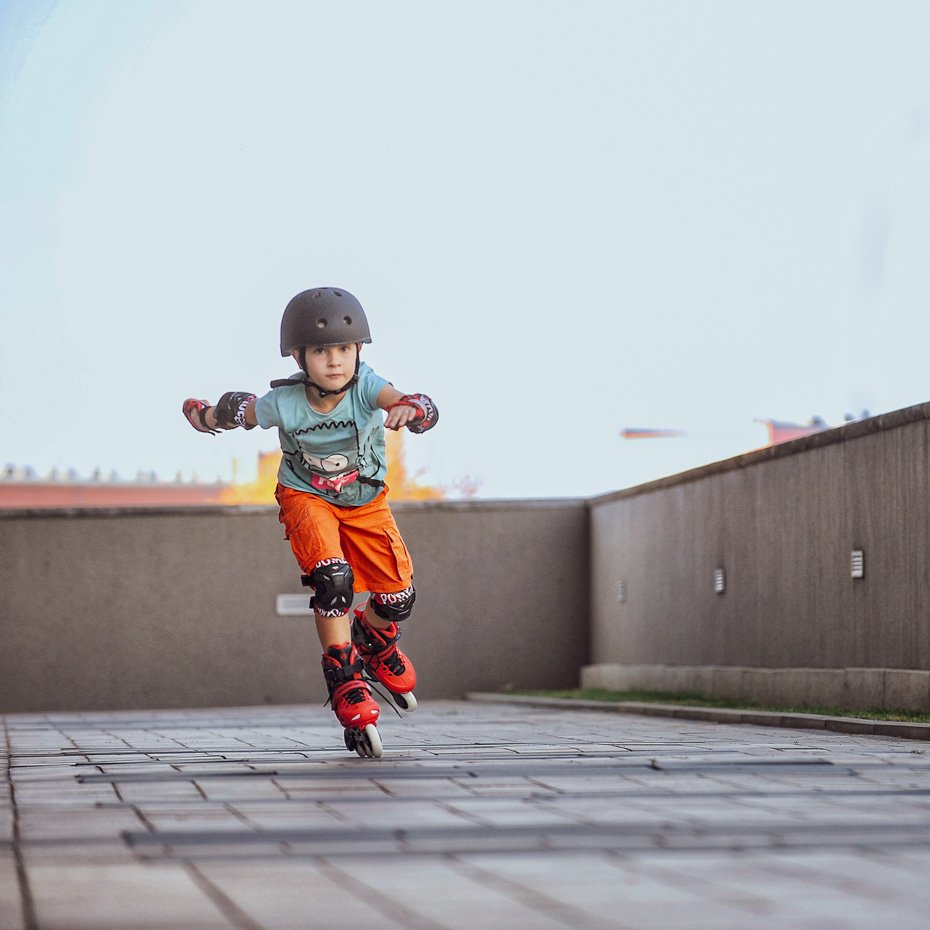
Types of Inline Skates for Kids
- Softboot inline skates for kids – Lightweight and very comfortable, made from soft materials similar to sports shoes that breathe well. This type of inline skates easily adapts to the child's foot
- Hardboot inline skates for kids – Stiffer skates offering better control and support. The hard boot is more resistant to impacts and falls. These skates provide more possibilities to master other disciplines like slalom or urban skating. The hard boot is often combined with an aluminum frame.
- Aggressive inline skates for kids – Usually, these are skates with a harder and bulkier boot, equipped with smaller wheels, an aggressive composite frame, and an additional shelf/soulplate for performing tricks on pipes and ledges.
- Slalom inline skates – A hard and stiff boot and an aluminum frame with additional rocker wheel adjustment for increased manoeuvrability. Slalom skates for kids are most often adjustable through a removable inner insert, and the boot itself is not extendable.
- Hockey inline skates – The boot's construction is based on a classic hockey skate. Instead of an ice blade, hockey inline skates are equipped with a frame and wheels. They allow children to train off-season when ice rinks are closed.
- Speed inline skates – Lacking a top buckle, having a low collar, a longer frame, and larger wheels with diameters of 84 mm - 100 mm. Created for riding long distances at high speeds. Skating on speed skates requires very good technique from the child and should be done under the supervision of a coach or experienced instructor.
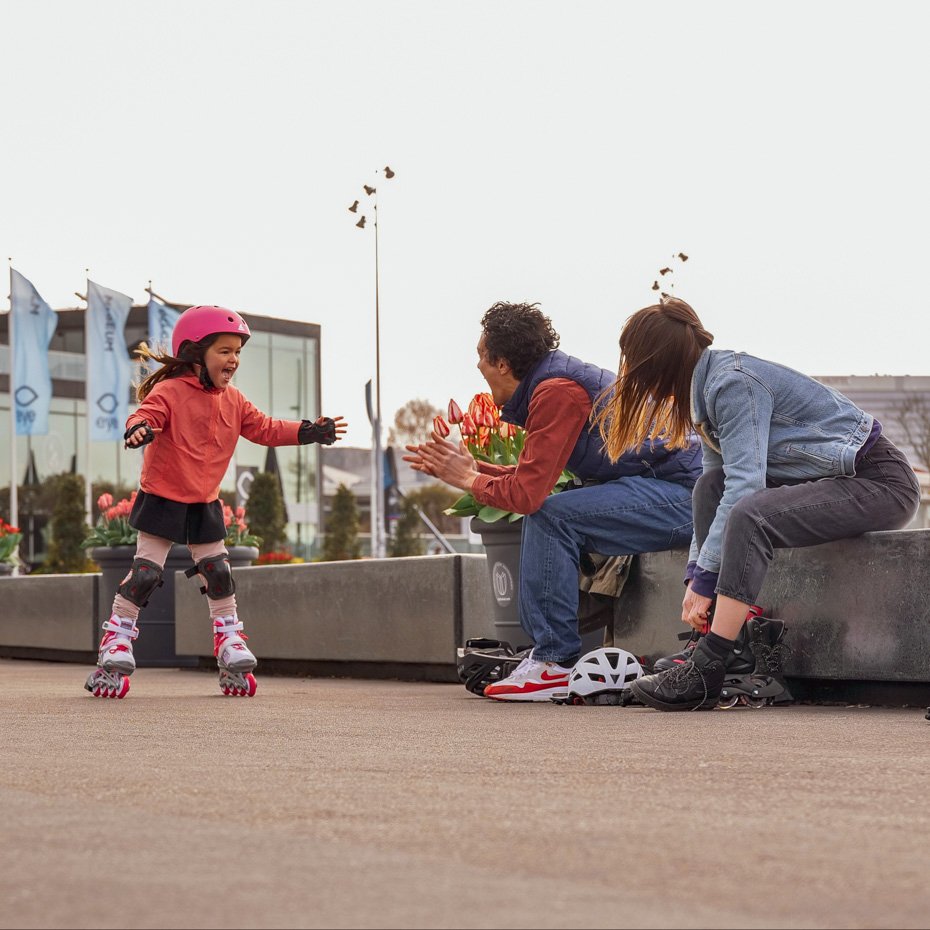
What to consider when choosing the best inline skates?
Identifying the best skates for your child doesn't equate to singling out one definitive model. Skates that meet their unique skating needs, perfectly fit their foot length, and showcase the hallmark features of excellent children's inline skates are the ideal choice. This indicates that a single model cannot possibly be the best solution for every child. By reflecting on a few basic yet crucial questions regarding your child's skating needs and preferences, you can more easily pinpoint the model that will best suit your young skater.
- What is the child's skill level? – For complete beginners without experience, choose softboot skates with 4 wheels. They will make it easier for the child to acquire new skills. If your little one is already doing well, choose hardboot skates. They will help further develop their craft and discover new horizons. Finally, consider their style of riding. If they like high speed on straightaways and a bit of evolution, choose hard skates with three wheels.
- Where will we most often ride? – If you are only going to ride in the park on a straight path, softboot skates for learning will be fully sufficient for a child. Skateparks, tracks for speed skating, skate parks with obstacles, or the city are tasks for hardboot skates.
- What style of riding does the child prefer? – If the child likes to jump or perform various complicated evolutions such as riding backwards or crossovers – definitely choose hardboot skates. For calm and conservative riding, a soft boot and composite frame will be appropriate.
- Do we want to enroll the child in lessons with an instructor? – Classes are very diverse, they include various elements of skating disciplines, like slalom, inline hockey, freeride or even jumps. Regardless of the level, choose hardboot skates.
- What is the child's fitness level? – If your child is very fit and has no problems quickly mastering new skills, choose hard skates for them. Your little one may quickly grasp the basics, so soft skates may prove insufficient after some time. For a child who needs more time to acquire skills, choose soft skates. A comfortable and lightweight boot will help them focus on riding.
- Other sports disciplines? – Does your child already ski or ice skate? In this case, they will quickly master the basics, so choose hardboot skates for them, even if these are their first skates. They will certainly appreciate and utilize their stiffness. If they like high speeds, consider a skate with three larger wheels.
- Skates for a specific discipline – If your child has already mastered the basics, and their style of riding and discipline are strongly directed, choose a skate adapted to a specific discipline. This will help the child fully utilize their potential.
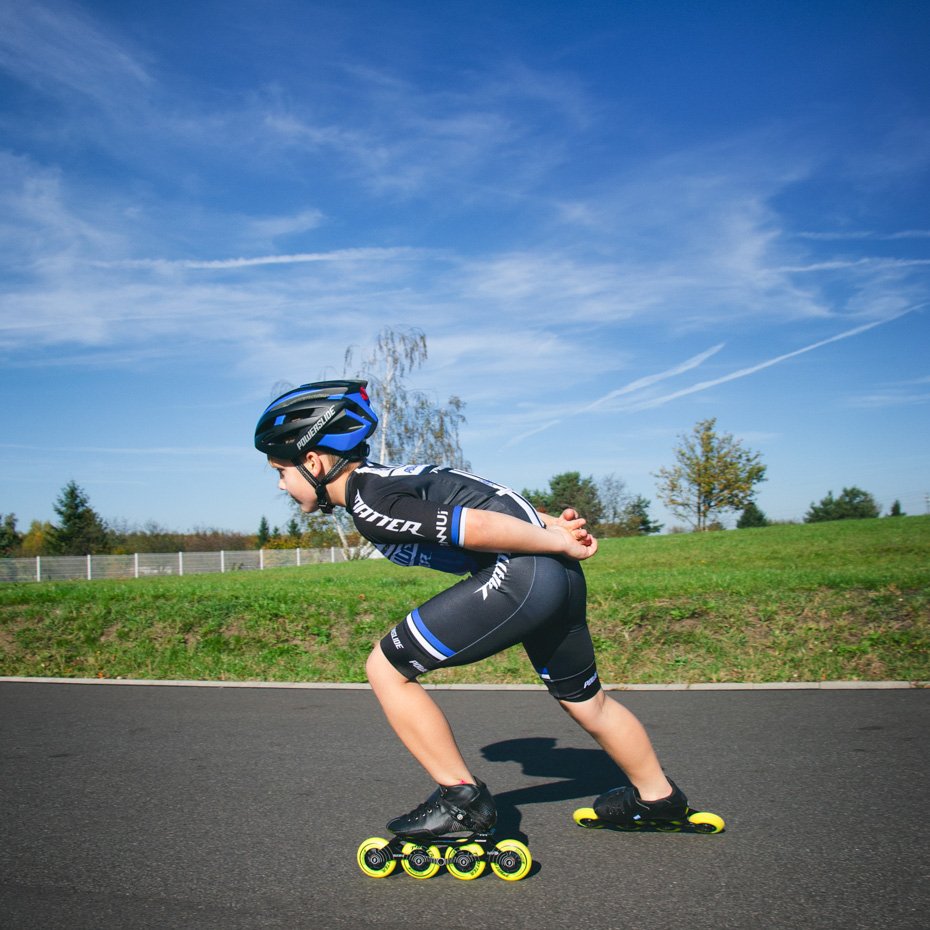
Recommended models for children
Based on the important skate features we've discussed, we have selected the most appealing children's inline skate models for different purposes, suitable for both boys and girls. These models are not only recommended by seasoned inline skating instructors but have also proven to be favorites among our customers. They're the preferred choice in many inline skating schools around the world. With the guidance we've offered, you should now have a good understanding of what to look for in skates for your child..
Kids inline skates for learning basics and recreational skating:
| Model: | Shell | Frames | Wheels | Sizes |
| Powerslide Stargaze | Hardboot | Unibody composite frames | 4 | 29-32 / 33-36 / 37-40 |
| Powerslide Khaan | Hardboot | Composite, Aluminum | 3/4 | 27-30 / 31-34 / 35-38 / 39-42 |
| Rollerblade Fury | Hardboot | Unibody composite frames | 4 | 29-32 / 33-36,5 / 36,5-40,5 |
| K2 Raider | Softboot | Unibody composite frames | 4 | 29-34 / 32-37 / 35-40 |
| K2 Marlee | Softboot | Unibody composite frames | 4 | 29-34 / 32-37 / 35-40 |
| Rollerblade Microblade | Softboot | Unibody composite frames | 3/4 | 28-32 / 33-36,5 / 36,5-40,5 |
| Powerslide Rocket | Softboot | Unibody composite frames | 4 | 29-32 / 33-36 / 37-40 |
| Seba Junior | Softboot | Unibody composite frames | 4 | 27-30 / 31-34 / 35-38 |
| K2 SK8 Hero | Softboot | Aluminum | 4 | 32-37 / 35-40 |
| K2 Charm | Softboot | Aluminum | 4 | 32-37 / 35-40 |
Kids inline skates for skill development and learning other skating disciplines.
| Model: | Shell | Frames | Wheels | Sizes |
| Powerslide Stargaze | Hardboot | Unibody composite frames | 4 | 29-32 / 33-36 / 37-40 |
| Powerslide Khaan | Hardboot | Composite, Aluminum | 3/4 | 27-30 / 31-34 / 35-38 / 39-42 |
| Rollerblade Fury | Hardboot | Unibody composite frames | 4 | 29-32 / 33-36,5 / 36,5-40,5 |
| Rollerblade Apex | Hardboot | Aluminum | 3/4 | 29-32 / 33-36 / 37-40 |
| Powerslide Phuzion Universe | Hardboot | Aluminum | 3/4 | 29-32 / 33-36 / 37-40 |
| Powerslide Jet | Hardboot | Aluminum | 3/4 | 27-30 / 31-34 / 35-38 |
| Seba ST MX | Hardboot | Aluminum | 4 | 29-32 / 33-36 / 37-40 |
| Seba E3 Junior | Hardboot | Aluminum | 4 | 35-37 / 37-39 |
| FR FR J | Hardboot | Aluminum | 4 | 32-34 / 35-37 / 37-39 / 40-42 |
| FR EZX | Hardboot | Aluminum | 4 | 29-32 / 33-36 / 37-40 |
{banner_slider}
Slalom inline skates:
| Model: | Shell | Frames | Wheels | Sizes |
| Seba SJ | Hardboot | Aluminum | 4 | 29-32 / 33-36 / 37-40 |
| FR FR J | Hardboot | Aluminum | 4 | 32-34 / 35-37 / 37-39 / 40-42 |
| FR AXS Junior - Rockering | Hardboot | Aluminum | 4 | 29-32 / 33-36 / 37-40 |
| FR EZX | Hardboot | Aluminum | 4 | 29-32 / 33-36 / 37-40 |
| Seba ST MX | Hardboot | Aluminum | 4 | 29-32 / 33-36 / 37-40 |
Agressive inline skates:
| Model: | Shell | Frames | Wheels | Sizes |
| Razors Genesys Junior | Hardboot | Composite | 2/4 | 36-39 |
| USD Transformer | Hardboot | Composite | 2/4 | 33-36 / 37-40 |
| Kaltik K Skate | Hardboot | Composite | 2/4 | 33-36 / 36-39 |
| Mesmer Throne Junior | Hardboot | Composite | 2/4 | 35-37 |
| USD Glitch | Hardboot | Composite | 2/4 | 31-34 / 35-38 |
Speed inline skates:
| Model: | Shell | Frames | Wheels | Sizes |
| Powerslide Core Performance Kids | Carbon | Aluminum | 4 | 34 / 35 / 36 |
| Powerslide 3X Kids | Composite | Aluminum | 3 | 31-34 / 34-37 |
| Powerslide 3X Evo Kids | Composite / Fiberglass | Aluminum | 3 | 31-34 / 34-37 |
| Powerslide Accel Kids | Carbon / Fiberglass | Aluminum | 4 | 32 / 33 / 34 / 35 |
Hockey inline skates:
| Model: | Shell | Frames | Wheels | Sizes |
| Powerslide Reign Ares Junior | Composite | Aluminum | 4 | 28-31 / 32-35 / 36-39 |
| CCM Tacks 9350 JR | Composite | Aluminum | 4 | 33,5 / 35 / 36 / 36,5 / 37,5 / 38 |
Most popular inline skates
Through our experience and cooperation with rollerblading instructors, it's evident that hardboot skates aimed at skill development and learning other disciplines are the top choice for young skaters. Such skates excel in teaching the basics and further skill development, providing an excellent cost-to-feature ratio. Their size-adjustability translates into long-term savings, covering several growth spurts. Choosing the correct skate model can initiate a prolonged and pleasurable rollerblading experience. High-quality and comfortable skates are a great incentive for children to spend time actively outdoors, highlighting the value of taking the time to make the right choice.
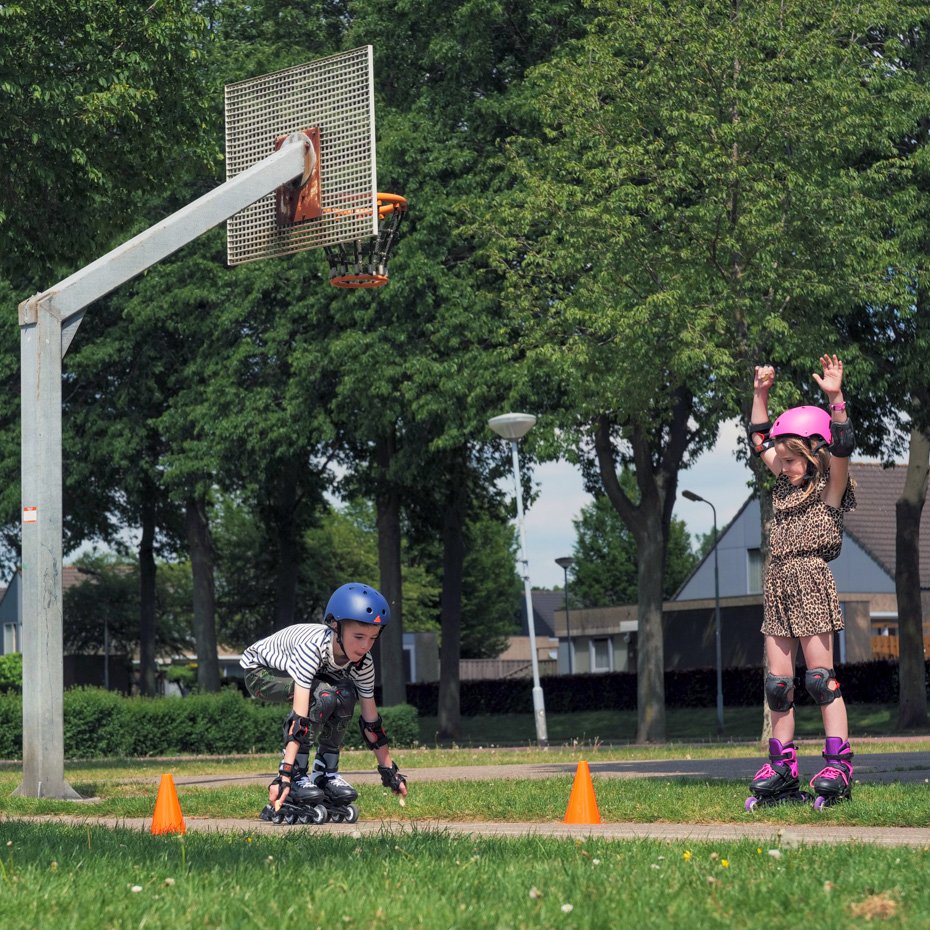
Suggestions and tips
How to measure skates with a child – Set the skates to the smallest possible size. Untie the laces and unbuckle all the buckles to comfortably put the skate on the child's foot. For this, the child should be sitting. Do not put on skates while standing, as the foot reaches the very end of the inner boot and the skate may seem too tight. Whether the size is right can only be judged after fully lacing up the boot and fastening all the buckles. At this point, you can stand up and take a position with bent knees. If these are the first skates, it will be easier to do this on a carpet or other soft surface. Ask your child if the toes are straight and not curling under, show a gesture of curled fingers with your hand to better convey the information. Leave the skates on the foot for longer, if they are not comfortable, your child will surely inform you. The toe should reach the very end of the liner. We described the entire process of measuring and choosing the size in a separate article.
Benefits of inline skating – You already know that rollerblading is a great form of active time spending, in addition, it shapes all the motor features of a child. Inline skates are also an excellent foundation for other sports disciplines. A child who skates will much faster master the technique of ice skating and skiing. This also works the other way around. If your child already skis, there is a good chance that they will quickly master the technique of rollerblading.
Avoid skates with one wheel in the front and two on the sides at the back – This equipment does not allow for skating as on quad skates due to the lack of swivel trucks, nor like on inline skates, where the wheels are arranged in a single line. Such a wheel configuration makes proper turning impossible. Riding on this kind of equipment often leads to the formation of bad habits that are difficult to eliminate. The problem is not the technique – but the unsuitable equipment. Well-chosen skates, the right size, and a stiff design will easily allow the child to maintain the correct position and balance.
Do not buy ice skate/inline skates or "3 in 1" skates – Although at first glance, ice skates and children's skates seem to be structurally similar, there are differences. Ice skates are designed for riding in low temperatures, so manufacturers use special materials to ensure thermal comfort on one hand and to wick away moisture on the other. Inline skates are ridden at significantly higher temperatures, so the purpose of the lining and upholstery is ventilation and cooling. We do not recommend "2 in 1" skates and roller skates. Original quad skates have trucks (movable frame for wheels) that allow for turning, among other things. Turning the 4x4 wheels in a frame on inline skates will prevent proper technical riding - no possibility of edge transitions, full pushes, or turning.
Inline skates or quad skates? – Inline skates are more stable front to back, and quad skates are more stable side-to-side, but in both cases, the riding position is the same (knees bent, body slightly leaned forward). The first steps, moving, and turning have a very similar technique, so for a child, it doesn’t matter whether they choose inline skates or quad skates. Inline skates will definitely be more versatile and more comfortable for everyday riding (they handle uneven surfaces better and are faster), while quad skates are better for stationary use - on a flat surface or at a rink.
Do not buy oversized skates as a reserve – Too large skates can lead to loss of control during riding, the formation of abrasions and blisters. Skates with unnecessary slack are difficult to fasten and do not offer proper ankle support. This can lead to bending during riding, making it difficult to achieve the correct technique. As a result – they can be dangerous. Therefore, for children, we buy adjustable skates, so as to always ensure the proper fit.
Cheap skates vs Expensive skates – Skates for children are specialized sports equipment, consisting of many components. To ensure the quality of these components, manufacturers spend hundreds of hours testing and perfecting them. It is impossible to create a complete pair of skates and a set of protectors that cost 40 euros, while a set of good quality wheels can cost exactly that much. In the case of cheaper skates, this will be the element that wears out first. In supermarket-grade skates, the plastic is not stiff enough. This can cause unwanted bow legs, muscle cramps, and even blisters. For the safety of your child, it is worth considering purchasing proven equipment. Cheaper skates may turn out to be more expensive to use over time due to the poor quality of the components.
Skates with three wheels or skates with four wheels – Three wheels accelerate a bit slower, then allow for achieving higher speeds and their easier maintenance. Skates with three wheels often have a larger wheel diameter and a higher center of gravity. For this reason, they may be better for children who like faster riding. Skates with four wheels are more universal, easier to master due to the lower center of gravity. They are easier to ride slalom and overcome obstacles in the skatepark.
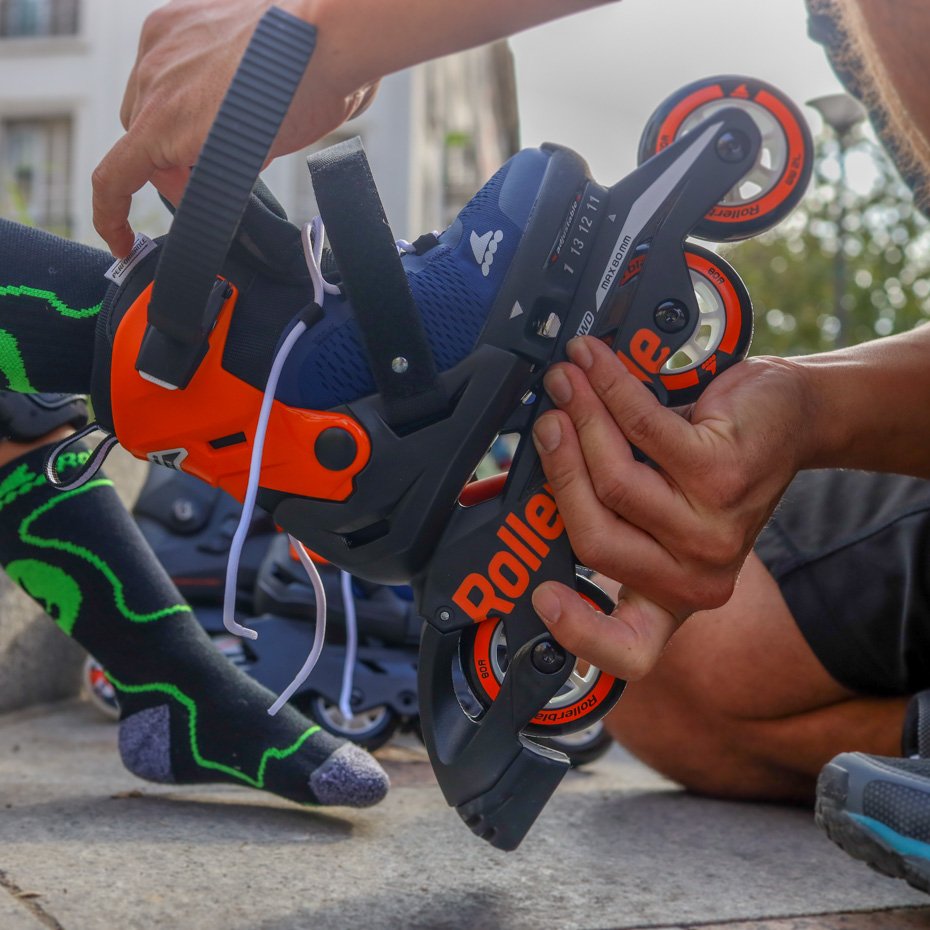
Frequently Asked Questions
- Q: At what age can children start inline skating? A: Children can start skating as early as 4 years old, but this is not a strict rule. Much depends on individual predispositions. The sizes of children's skates start from EU 27 and go up to EU 40. An experienced instructor can help assess whether your child is ready to skate.
- Q: Are inline skates safe? A: Yes, provided they are properly fitted and serviced, the child rides in a helmet and pads, and their challenges are matched to their abilities. Everything should be done under the watchful eye of an adult or instructor. These factors will definitely improve the safety of every rollerblade user.
- Q: Best places to skates with children? A: Places specifically designed for this purpose include roller rinks, skateparks, parks with long trails, or asphalt courts. For learning, choose a less crowded place without inclines and with smooth asphalt without holes, so your child can master the basics in the best conditions. A piece of lawn nearby can help get used to the skates and learn how to stand still or adopt the correct position on the skates. For advanced skaters, any place can be good. Slopes, tight turns, and narrow streets are an exciting way to further develop and diversify the ride. Nonetheless, always remember the safety of your child and others. Organized camps and day camps are also a great place to skate, where under the watchful eye of instructors, children have fun and acquire new skills every day.
- Q: Is it worth using an instructor? A: Definitely, especially for beginner children. This will facilitate the development of proper technique and habits. A solid foundation will help in further skill development. Riding with an instructor is also great fun thanks to organized group or individual lessons. An instructor can also assess whether the child is ready to start the skating journey.
- Q: Can adults ride children's inline skates? A: For their own safety, adults should not use them. The construction of children's skates is not adapted to the size and weight of adults.
- Q: Is a helmet and protectors necessary? A: Helmets and protectors for children significantly improve safety and protect against injuries such as abrasions, fractures, or bruises. They build the child's confidence. Children often fall while riding, so for their safety, protectors and a helmet are required.
- Q: Should I buy skates with room to grow into? A: Do not buy too big - choose adjustable. The skate must be as well fitted to the foot as possible. No slack means better control, better support, and less risk of abrasions and blisters . A well-fitted skate increases the safety of use.
- Q: How to measure the foot length before purchase? A: Place the child's foot on a sheet of paper and push the heel up against the wall. The child's back should be against the wall and their posture straight. Trace the foot on the paper and measure the length of the outline. Compare the result with the size chart. More information on measuring can be found here.
Summary
Choosing skates for a child is undoubtedly a significant challenge. By becoming familiar with the features of skates and their purpose, it can become incredibly simple and limited only to the color of a specific model. If you still have doubts or questions after reading our guide – Feel free to use our help and contact us.


